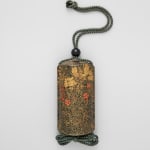A Five-Case Lacquer Inro, Meiji Period (Late 19th Century)
The inro is decorated overall with sprays of chrysanthemums (kiku), bush clover (hagi), branches of cherry (sakura) and plum (ume), peonies (botan), iris (shobu), and fringed pinks (nadeshiko), lotus leaves (hasu) to the base and further bush clover to the top.
9 cm. (3 1/2 in.) high
Signed in seal form in red lacquer: 'Shiomi Masanari'
Sold
Decorated in gold, silver, red, and green togidashi and kinpun against a black lacquer ground with hirame, nashiji interiors and risers, fundame rims. The plants that cover this inro indicate...
Decorated in gold, silver, red, and green togidashi and kinpun against a black lacquer ground with hirame, nashiji interiors and risers, fundame rims.
The plants that cover this inro indicate the various seasons. The cherry is associated with spring, the iris with early summer; the peony with high summer, the lotus with late summer, the wild pink, chrysanthemum and bush clover with early autumn; the maple with later autumn and the gnarled plum with late winter.
The plants that cover this inro indicate the various seasons. The cherry is associated with spring, the iris with early summer; the peony with high summer, the lotus with late summer, the wild pink, chrysanthemum and bush clover with early autumn; the maple with later autumn and the gnarled plum with late winter.
Provenance
The Ankarcrona collection
Sten Ankarcrona (1861-1936) started collecting Japanese works of art as a young officer in the Swedish navy. On his first visit to Japan in the late 1880s he became fascinated by the intricacies of Japanese lacquer, making numerous purchases, and continued to add to his collection after his return to Europe. In 1923, by then an admiral, he went back to Japan at the request of the King of Sweden, at which time he made numerous more purchases. The collection was then further added to by the admiral's descendants throughout the 20th and early 21st centuries.
Publications
Eskenazi Ltd., Japanese Inro and Lacquer-ware from a Private Swedish Collection, (London, 1996), no. 19, p. 30-31.1
of
6




